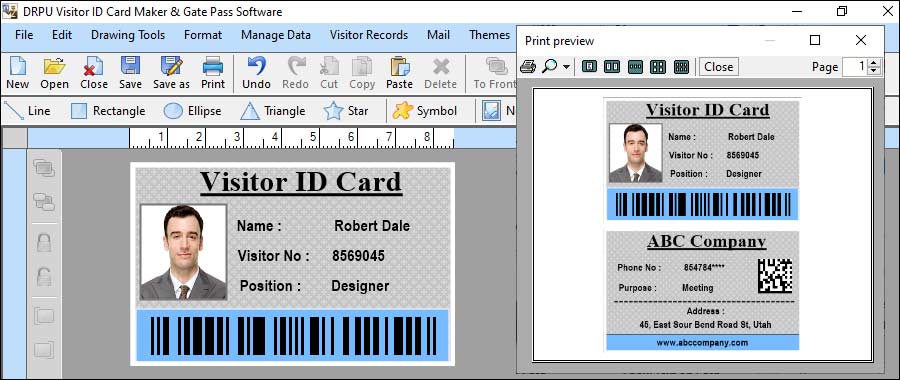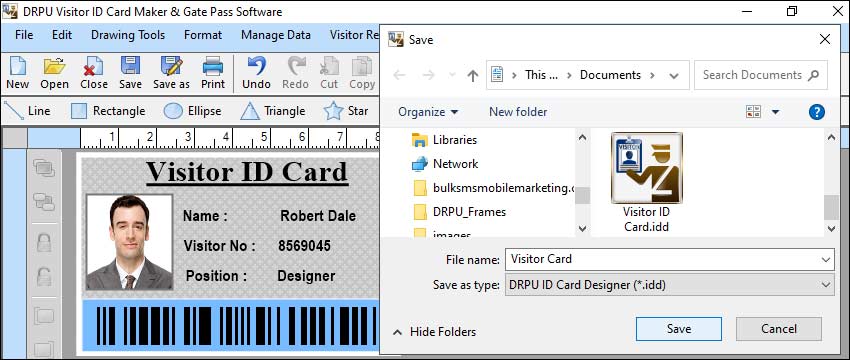Is it possible to use a visitor ID card maker to print on both sides of the card
Yes, it is possible to use a visitor ID card maker to print on both sides of the card, but it depends on the specific capabilities of the card maker and the printer being used. Here's an explanation of how it can be achieved:

-
Dual-Sided Printing Capability:
To print on both sides of a visitor ID card, you would need a visitor ID card maker that supports dual-sided printing. This means that the card maker should have the necessary hardware and software features to handle the printing process for both the front and back sides of the card.
-
Printer Compatibility:
In addition to the card maker's capabilities, you would also require a compatible printer that supports dual-sided printing. Not all printers are designed to print on both sides of a card, so it is important to choose a printer that specifically mentions this capability.
-
Printer Setup:
Once you have a visitor ID card maker with dual-sided printing capability and a compatible printer, you would need to set up the printer correctly. This typically involves installing the printer drivers and software provided by the manufacturer and configuring the printer settings to enable dual-sided printing.
-
Designing the ID Card:
Using the software provided by the visitor ID card maker, you can design the front and back of the ID card separately. You can include different elements such as the visitor's photo, name, organization, logo, barcode, and any other relevant information on each side of the card.
-
Printing Process:
With the card design ready, you can initiate the printing process. The visitor ID card maker's software will communicate with the printer and send the print job. The printer will then print the front side of the card based on the design specifications.
-
Card Flipping and Printing:
After printing the front side, the printer will prompt you to manually flip the card or will automatically flip the card if it has a built-in card-flipping mechanism. Once the card is flipped, the printer will continue printing on the back side of the card.
-
Finishing and Output:
Once both sides of the card have been printed, the printer will complete the printing process. The finished ID card can be ejected from the printer, and it is ready for use as a dual-sided visitor ID card.
In conclusion, it is possible to use a visitor ID card maker to print on both sides of a card by ensuring that the card maker and printer support dual-sided printing, properly setting up the printer, designing the card with separate front and back elements, and following the printing process with card flipping as required.
It is worth noting that the specific steps and processes involved may vary depending on the manufacturer and model of the visitor ID card maker and printer being used. It is recommended to refer to the user manuals and documentation provided by the manufacturers for detailed instructions on setting up and using the dual-sided printing feature.
Types of printers are compatible with a visitor ID card maker
In this article, we will explore the different types of printers compatible with a visitor ID card maker, discussing their features, advantages, and limitations.
Direct-to-Card printers, commonly known as DTC printers, are one of the most popular types of printers used for visitor ID card production. These printers utilize a thermal transfer printing process to transfer ink directly onto the surface of a PVC or composite plastic card. DTC printers are compatible with most visitor ID card makers and offer several advantages:
-
Print Quality:
DTC printers produce high-quality ID cards with sharp images, vibrant colors, and clear text. They are capable of printing detailed graphics and intricate designs, ensuring professional-looking visitor badges.
-
Speed:
DTC printers offer fast printing speeds, allowing for quick production of visitor ID cards. This is particularly beneficial for organizations that experience a high volume of visitors and require efficient badge issuance.
-
Versatility:
DTC printers are versatile and can print on various card types, including standard PVC cards, proximity cards, and smart cards. This versatility enables organizations to choose the most suitable card type for their specific needs.
-
Cost-Effectiveness:
DTC printers are generally affordable, making them a cost-effective option for organizations with a moderate printing volume. Additionally, they use a ribbon-based printing system, which reduces ink wastage and lowers operational costs.
-
Single-Sided Printing:
Most entry-level DTC printers are designed for single-sided printing. While this is sufficient for basic visitor ID cards, organizations requiring dual-sided printing capabilities may need to consider other printer types.
-
Print Durability:
DTC printers provide satisfactory durability for standard visitor ID cards. However, if the ID cards will be subject to extensive use or environmental factors, additional protection, such as lamination, may be necessary.
Retransfer printers, also known as reverse transfer or high-definition printers, are an alternative option for visitor ID card production. These printers use a two-step printing process involving the transfer of an image from a specialized ribbon onto a retransfer film, which is then thermally bonded to the surface of the card. Retransfer printers offer several advantages:
-
Superior Print Quality:
Retransfer printers provide exceptional print quality, surpassing that of DTC printers. The two-step process ensures precise image placement, resulting in sharp details, vivid colors, and photo-like card prints.
-
Dual-Sided Printing:
Unlike many DTC printers, retransfer printers often offer dual-sided printing capabilities. This allows organizations to include additional information or branding on the back of the visitor ID cards, enhancing their functionality and aesthetics.
-
Increased Durability:
Retransfer printers produce ID cards with enhanced durability. The retransfer film acts as a protective layer, making the cards more resistant to wear, fading, and tampering. This is particularly important for long-term visitor badges or cards subject to rough handling.
-
Compatibility with Various Card Materials:
Retransfer printers are compatible with a wide range of card materials, including PVC, composite PVC, PET, and polycarbonate. This versatility allows organizations to select the most suitable card material based on their specific security and durability requirements.
-
Slower Printing Speed:
Compared to DTC printers, retransfer printers typically have slower printing speeds. The two-step printing process and higher print resolution contribute to longer printing times. Therefore, organizations with time-sensitive badge issuance may need to consider this factor.
-
Higher Cost:
Retransfer printers are generally more expensive than DTC printers, both in terms of upfront costs and ongoing maintenance. The specialized printing technology and additional components contribute to the higher price tag.
Inkjet printers are another type of printer that can be compatible with certain visitor ID card makers. These printers use liquid ink sprayed onto the card's surface to create images and text. While inkjet printers are commonly used for document printing, they may have some advantages and limitations when applied to visitor ID card production:
Advantages of inkjet printers include:
-
Superior Print Quality:
Print Quality: Inkjet printers can produce high-quality prints with sharp text and vibrant colors. They are suitable for basic visitor ID cards that do not require intricate graphics or high-resolution photos.
-
Compatibility
Inkjet printers may have limitations when it comes to card compatibility. They may not be suitable for printing on certain card materials, such as PVC or composite cards, which are commonly used for visitor ID cards.
-
Ease of Use:
Inkjet printers are relatively easy to operate and maintain. They often have a straightforward setup process and do not require extensive training.
-
Cost-Effectiveness:
Inkjet printers are generally more affordable than DTC and retransfer printers, making them an economical option for organizations with a limited budget or low printing volume.
-
Durability:
Inkjet prints may not be as durable as those produced by DTC or retransfer printers. The ink can smudge or fade over time, especially when exposed to moisture or abrasion. Therefore, inkjet-printed visitor ID cards may not be suitable for long-term use.
-
Printing Speed:
Inkjet printers are generally slower compared to DTC and retransfer printers. This can be a disadvantage for organizations that need to issue visitor ID cards quickly or handle high volumes of visitors.
When selecting a printer for a visitor ID card maker, organizations should consider their specific requirements, budget, and printing volume. Direct-to-Card printers are a popular choice due to their versatility, affordability, and fast printing speeds. Retransfer printers offer superior print quality, increased durability, and dual-sided printing capabilities, making them ideal for organizations with higher quality standards or long-term card use. Inkjet printers can be a cost-effective option for organizations with basic printing needs and limited budgets, but they may not provide the same level of durability or versatility as DTC or retransfer printers. Ultimately, the choice of printer should align with the organization's priorities and desired outcomes for visitor ID card production.
Can I save visitor ID card templates for future use with a visitor ID card maker
Yes, it is generally possible to save visitor ID card templates for future use with a visitor ID card maker. Visitor ID card makers are software applications or online tools that allow you to design and create customized visitor ID cards. These tools usually provide a range of design options, including templates that can be modified to suit your specific needs.

-
Future Use:
When you want to create visitor ID cards in the future, simply open your visitor ID card maker tool and access the saved template from your designated storage location. You can load the template and make any necessary adjustments for specific visitor you are issuing the ID .
-
Explore Template Options:
Once you have chosen a visitor ID card maker, browse through the available template options. These templates serve as a starting point for your ID card design and can often be customized to fit your needs. Look for templates that match your desired style and layout.
-
Customize the Template:
After selecting a template, you can modify it according to your preferences. Most ID card makers offer a user-friendly interface where you can easily edit elements such as text, images, colors, and background. You can add your organization's logo, visitor's photo, name, and any other necessary details.
-
Save the Template:
Once you have personalized the template to your satisfaction, the visitor ID card maker will typically provide an option to save your design. This could involve saving the file to your computer, exporting it as an image, or storing it within the ID card maker's online platform. Follow the instructions provided by the tool to save your template.
-
Organize and Store Templates:
It is a good practice to create a dedicated folder or directory on your computer or cloud storage platform to store your visitor ID card templates. This way, you can easily locate and retrieve them when needed.
-
Select a Visitor ID Card Maker:
Choose a visitor ID card maker tool that suits your requirements. There are various options available, including online platforms, desktop software, or mobile applications.
In conclusion, By saving visitor ID card templates, you can streamline the card creation process for future visitors. This method allows you to maintain consistency in design, branding, and layout, and it saves you time as you won't need to start from scratch each time you need to create a new ID card.
Remember to review and update the template periodically to ensure the information remains accurate and up to date, reflecting any changes in your organization's policies or branding.